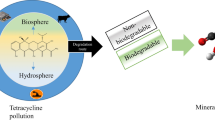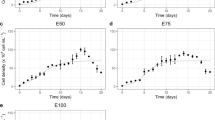Abstract
Ecotoxic effects of antibiotics or ammonium have been confirmed independently in aquatic animals, but few studies have investigated their combined effects. In aquaculture ecosystems, these pollutants frequently coexist, and often in high concentrations. In this study, the combined effects of antibiotic nitrofurazone and NH4Cl on the population dynamics and growth rates of two species of ciliated protists, Euplotes vannus and Pseudokeronopsis rubra, were investigated. Profiles of the dose-responses were visualized, and interactions between the two pollutants were quantified by the response surface method (RSM). Results showed that 1) the dynamics of the population growth differed significantly between the testd ciliates and varied with the concentrations of the pollutants; 2) the relative growth rate (RGR) of both ciliates decreased significantly with increased pollutant concentrations, while the difference in RGR between the two ciliates was not significant; 3) RSM analysis demonstrated an additive effect of nitrofurazone and NH4Cl on the RGR in both ciliates. In brief, ecotoxic effects can be caused by nitrofurazone and ammonium independently on the two test ciliates, and such effects can be strengthened when they present at the same time. These findings offer a valuable reference for evaluating combined ecotoxic effects caused by multiple pollutants in aquaculture ecosystems.
Similar content being viewed by others
References
Belwal, T., Dhyani, P., Bhatt, I. D., Rawal, R. S., and Pande, V., 2016. Optimization extraction conditions for improving phenolic content and antioxidant activity in Berberis asiatica fruits using response surface methodology (RSM). Food Chemistry, 207: 115–124.
Bendall, J. G., Crawford, R. A., Evers, J. M., Smythe, B. W., Bessaire, T., Mottier, P., Mujahid, C., Aleksic, G., and Hutchinson, R., 2019. Determination of nitrofurazone in fluid milk and dairy powders. Part 1: An international pilot study. International Dairy Journal, 91: 185–192.
Chen, X., Clamp, J. C., and Song, W., 2011. Phylogeny and systematic revision of the family Pseudokeronopsidae (Protista, Ciliophora, Hypotricha), with description of a new estuarine species of Pseudokeronopsis. Zoologica Scripta, 40: 659–671.
Colorni, A., and Paperna, I., 1983. Evaluation of nitrofurazone baths in the treatment of bacterial infections of Sparus aurata and Oreochromis mossambicus. Aquaculture, 35: 181–186.
Draper, N. R., 1997. Response surface methodology: Process and product optimization using designed experiments. Journal of Statistical Planning and Inference, 59: 185–186.
Du, N., Chen, M., Sheng, L., Chen, S., Xu, H., Liu, Z., Song, C., and Qiao, R., 2014. Determination of nitrofuran metabolites in shrimp by high performance liquid chromatography with fluorescence detection and liquid chromatography-tandem mass spectrometry using a new derivatization reagent. Journal of Chromatography A, 1327: 90–96.
Ebeling, J. M., Timmons, M. B., and Bisogni, J. J., 2006. Engineering analysis of the stoichiometry of photoautotrophic, autotrophic, and heterotrophic removal of ammonia-nitrogen in aquaculture systems. Aquaculture, 257: 346–358.
Esteban, G. F., and Finlay, B. J., 2007. Exceptional species richness of ciliated Protozoa in pristine intertidal rock pools. Marine Ecology Progress Series, 335: 133–141.
Farzana, S., and Tam, N. F. Y., 2018. A combined effect of poly-brominated diphenyl ether and aquaculture effluent on growth and antioxidative response of mangrove plants. Chemosphere, 201: 483–491.
Ghersi-Egea, J. F., Maupoil, V., Ray, D., and Rochette, L., 1998. Electronic spin resonance detection of superoxide and hydroxyl radicals during the reductive metabolism of drugs by rat brain preparations and isolated cerebral microvessels. Free Radical Biology and Medicine, 24: 1074–1081.
Groenveld, T., Kohn, Y. Y., Gross, A., and Lazarovitch, N., 2019. Optimization of nitrogen use efficiency by means of fertigation management in an integrated aquaculture-agriculture system. Journal of Cleaner Production, 212: 401–408.
Han, Q., Zhao, S., Zhang, X., Wang, X. L., Song, C., and Wang, S., 2020. Distribution, combined pollution and risk assessment of antibiotics in typical marine aquaculture farms surrounding the Yellow Sea, North China. Environment International, 138: 105551.
Hegazi, M. M., Attia, Z. I., and Ashour, O. A., 2010. Oxidative stress and antioxidant enzymes in liver and white muscle of Nile tilapia juveniles in chronic ammonia exposure. Aquatic Toxicology, 99: 118–125.
Hiraku, Y., Sekine, A., Nabeshi, H., Midorikawa, K., Murata, M., Kumagai, Y., and Kawanishi, S., 2004. Mechanism of carcinogenesis induced by a veterinary antimicrobial drug, ni-trofurazone, via oxidative DNA damage and cell proliferation. Cancer Letters, 215: 141–150.
Hoffmann, W. A., and Poorter, H., 2002. Avoiding bias in calculations of relative growth rate. Annals of Botany, 90: 37–42.
Holt, R. D., Grover, J., and Tilman, D., 1994. Simple rules for interspecific dominance in systems with exploitative and apparent competition. American Naturalist, 144: 741–771.
Hong, Y., Lin, X., Cui, X., Zhou, L., Al-Rasheid, K. A. S., and Li, J., 2015. Comparative evaluation of genotoxicity induced by nitrofurazone in two ciliated protozoa by detecting DNA strand breaks and DNA-protein crosslinks. Ecological Indicators, 54: 153–160.
Hong, Y., Tan, Y., Meng, Y., Yang, H., Zhang, Y., Warren, A., Li, J., and Lin, X., 2017. Evaluation of biomarkers for ecotoxicity assessment by dose-response dynamic models: Effects of nitrofurazone on antioxidant enzymes in the model ciliated protozoan Euplotes vannus. Ecotoxicology and Environmental Safety, 144: 552–559.
Hu, S., and Zhang, D., 1993. The effects of initial population-density on the competition for limiting nutrients in 2 freshwater algae. Oecologia, 96: 569–574.
Hu, X., and Song, W., 2001. Morphological redescription and morphogenesis of the marine ciliate, Pseudokeronopsis rubra (Ciliophora, Hypotrichida). Acta Protozoologica, 40: 107–115.
Ito, K., Kajikawa, S., Aisuke, N., Hanada, T., and Doi, K., 2003. Antioxidants suppress nitrofurazone-induced proliferation of hepatocytes. Experimental and Toxicologic Pathology, 55: 247–250.
Kari, F. W., Huff, J. E., Leininger, J., Haseman, J. K., and Eustis, S. L., 1989. Toxicity and carcinogenicity of nitrofurazone in F344/N rats and B6C3F1 mice. Food and Chemical Toxicology, 27: 129–137.
Kim, J. H., Kang, Y. J., Kim, K. I., Kim, S. K., and Kim, J. H., 2019. Toxic effects of nitrogenous compounds (ammonia, nitrite, and nitrate) on acute toxicity and antioxidant responses of juvenile olive flounder, Paralichthys olivaceus. Environmental Toxicology and Pharmacology, 67: 73–78.
Li, X., Huang, J., Filker, S., Stoeck, T., Bi, Y., Yu, Y., and Song, W., 2019. Spatio-temporal patterns of zooplankton in a main-stem dam affected tributary: A case study in the Xiangxi River of the Three Gorges Reservoir, China. Science China. Life Sciences, 62: 1058–1069.
Li, X., Li, W., Zhai, J., Wei, H., and Wang, Q., 2019. Effect of ammonium nitrogen on microalgal growth, biochemical composition and photosynthetic performance in mixotrophic cultivation. Bioresource Technology, 273: 368–376.
Liu, X., Steele, J. C., and Meng, X., 2017. Usage, residue, and human health risk of antibiotics in Chinese aquaculture: A review. Environmental Pollution, 223: 161–169.
Macri, A., and Sbardella, E., 1984. Toxicological evaluation of ni-trofurazone and furaltadone on Selenastrum capricornutum, Daphnia magna, and Musca domestica. Ecotoxicology and Environmental Safety, 8: 101–105.
Madoni, P., and Romeo, G. M., 2006. Acute toxicity of heavy metals towards freshwater ciliated protists. Environmental Pollution, 141: 1–7.
Martinez, P. G., Winston, G. W., Metashdickey, C., Ohara, S. C. M., and Livingstone, D. R., 1995. Nitrofurantoin-stimulated reactive oxygen species production and genotoxicity in digestive gland microsomes and cytosol of the common mussel (Mytilus edulis L.). Toxicology and Applied Pharmacology, 131: 332–341.
McCracken, R. J., Blanchflower, W. J., Rowan, C., McCoy, M. A., and Kennedy, D. G., 1995. Determination of furazolidone in porcine tissue using thermospray liquid chromatography-mass spectrometry and a study of the pharmacokinetics and stability of its residues. Analyst, 120: 2347–2351.
Montagnes, D., Roberts, E., Lukeš, J., and Lowe, C., 2012. The rise of model protozoa. Trends in Microbiology, 20: 184–191.
Murphy, A. E., Nizzoli, D., Bartoli, M., Smyth, A. R., Castaldelli, G., and Anderson, I. C., 2018. Variation in benthic metabolism and nitrogen cycling across clam aquaculture sites. Marine Pollution Bulletin, 127: 524–535.
Payne, R. J., 2013. Seven reasons why protists make useful bioindicators. Acta Protozoologica, 52: 105–113.
Pianka, E. R., 1970. On r and K selection. American Naturalist, 104: 592–597.
Pörtner, H. O., Schulte, P. M., Wood, C. M., and Schiemer, F., 2010. Niche dimensions in fishes: An integrative view. Physiological and Biochemical Zoology, 83: 808–826.
Rodrigues, R. V., Romano, L. A., Schwarz, M. H., Delbos, B., and Sampaio, L. A., 2014. Acute tolerance and histopathological effects of ammonia on juvenile maroon clownfish Premnas biaculeatus (Block 1790). Aquaculture Research, 45: 1133–1139.
Romano, N., and Zeng, C., 2009. Acute toxicity of sodium nitrate, potassium nitrate, and potassium chloride and their effects on the hemolymph composition and gill structure of early juvenile blue swimmer crabs (Portunus pelagicus Linnaeus, 1758) (Decapoda, Brachyuran, Portunidae). Environmental Toxicology and Chemistry, 26: 1955–1962.
Ruan, Y., Dou, Y., Chen, J., Warren, A., Li, J., and Lin, X., 2018. Evaluation of phenol-induced ecotoxicity in two model ciliate species: Population growth dynamics and antioxidant enzyme activity. Ecotoxicology and Environmental Safety, 166: 176–185.
Sarma, S. S. S., Iyer, N., and Dumont, H. J., 1996. Competitive interactions between herbivorous rotifers: Importance of food concentration and initial population density. Hydrobiologia, 331: 1–7.
Smolders, R., Bervoets, L., De Coen, W., and Blust, R., 2004. Cellular energy allocation in zebra mussels exposed along a pollution gradient: Linking cellular effects to higher levels of biological organization. Environmental Pollution, 129: 99–112.
Tao, H., Tang, X. Y., Jin, L., Zhao, Y. C., Luo, Y., Zhang, Z., Cai, L., Tao, F. H., and Guo, W. C., 2018. Synergistic effect of docetaxel combined with cisplatin on inhibiting human osteosarcoma in nude mice. Biochemical and Biophysical Research Communications, 505: 372–377.
Tilman D., 1982. Resource Competition and Community Structure. Princeton University Press, Princeton, NJ, 1–296.
Välitalo, P., Kruglova, A., Mikola, A., and Vahala, R., 2017. Toxicological impacts of antibiotics on aquatic micro-organisms: A mini-review. International Journal of Hygiene and Environmental Health, 220: 558–569.
Van Duc, L., Song, B., Ito, H., Hama, T., Otani, M., and Kawagoshi, Y., 2018. High growth potential and nitrogen removal performance of marine anammox bacteria in shrimp-aquaculture sediment. Chemosphere, 196: 69–77.
Vlastos, D., Moshou, H., and Epeoglou, K., 2010. Evaluation of genotoxic effects of semicarbazide on cultured human lymphocytes and rat bone marrow. Food and Chemical Toxicology, 48: 209–214.
Weinbauer, M. G., and Höfle, M. G., 1998. Distribution and life strategies of two bacterial populations in a eutrophic lake. Applied and Environmental Microbiology, 64(10): 3776–3783.
Xiang, F., Yang, W., Chen, Y., and Yang, Z., 2010. Acute toxi-city of nitrite and ammonia to Daphnia similoides of different developmental stages: Using the modified Gaussian model to describe. Bulletin of Environmental Contamination and Toxicology, 84: 708–711.
Xu, H., Zhu, M., Jiang, Y., Gao, S., Min, G. S., and Al-Rasheid, K. A. S., 2011. Population dynamics of marine ciliate Euplotes vannus (Protozoa, Ciliophora) in different artificial sea-waters. Chinese Journal of Oceanology and Limnology, 29: 109–117.
Yang, J., Hu, W., Tan, Y., Warren, A., Lin, X., and Li, J., 2019. Combined effects of food resources and exposure to ammonium nitrogen on population growth performance in the bac-terivorous ciliate Paramecium caudatum. European Journal of Protistology, 71: 125631.
Zeng, C., Gonzalez-Alvarez, A., Orenstein, E., Field, J. A., Shadman, F., and Sierra-Alvarez, R., 2017. Ecotoxicity assessment of ionic As(III), As(V), In(III) and Ga(III) species potentially released from novel III-V semiconductor materials. Ecotoxi-cology and Environmental Safety, 140: 30–36.
Zhou, L., Li, J., Lin, X., and Al-Rasheid, K. A. S., 2011. Use of RAPD to detect DNA damage induced by nitrofurazone in marine ciliate, Euplotes vannus (Protozoa, Ciliophora). Aquatic Toxicology, 103: 225–232.
Acknowledgements
This work was supported by the National Natural Science Foundation of China (Nos. 31971519, 31430077, 41476128) and in part by a grant from the Dedicated Fund for Promoting High-Quality Economic Development in Guangdong Province (Marine Economic Development Project: GDOE(2019)A23).
Author information
Authors and Affiliations
Corresponding author
Rights and permissions
About this article
Cite this article
Yu, Z., Liu, S., Chen, X. et al. Comparative Evaluation on Combined Ecotoxic Effects of Nitrofurazone and NH4CI Using Two Ciliated Protists as Model Organisms: Population Dynamics and Growth Rates. J. Ocean Univ. China 20, 137–146 (2021). https://doi.org/10.1007/s11802-021-4410-3
Received:
Revised:
Accepted:
Published:
Issue Date:
DOI: https://doi.org/10.1007/s11802-021-4410-3




